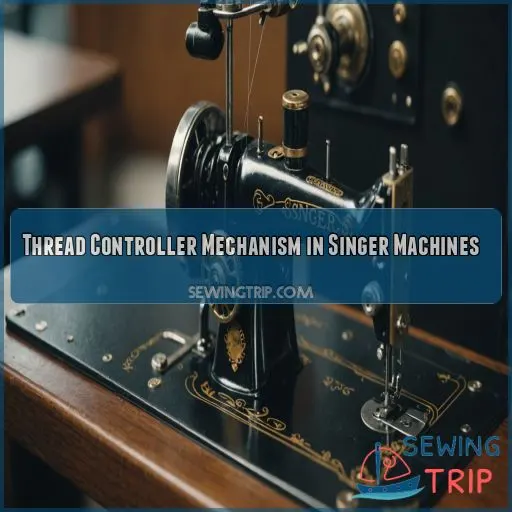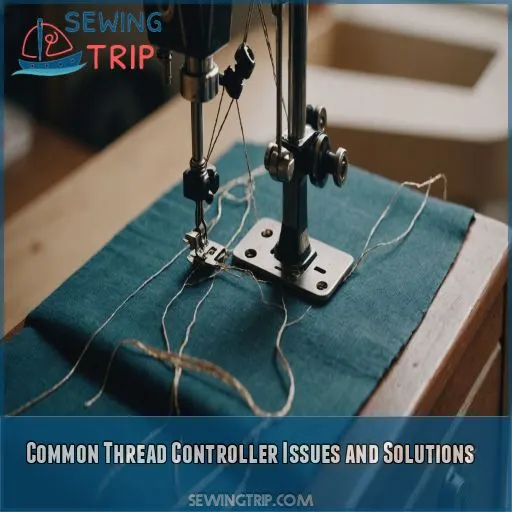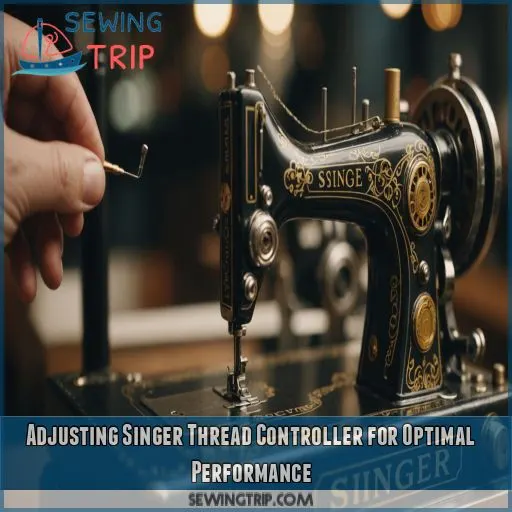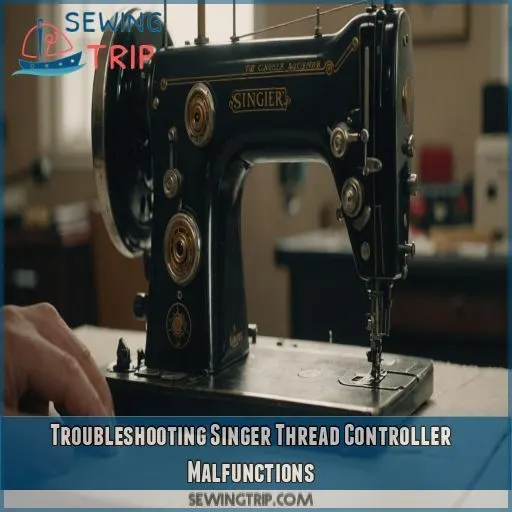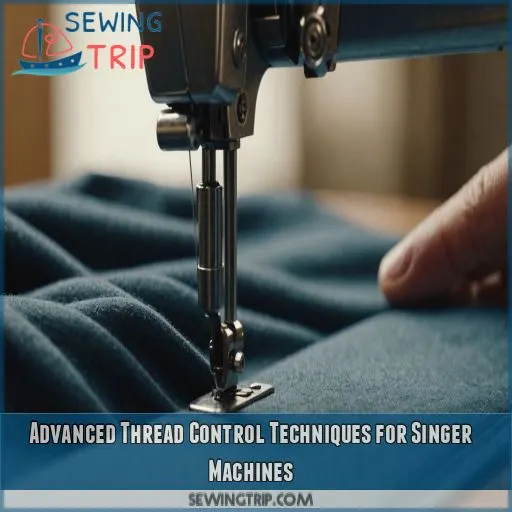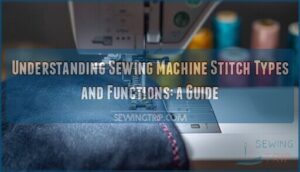This site is supported by our readers. We may earn a commission, at no cost to you, if you purchase through links.

It’s like having a tiny tension expert living inside your machine, constantly adjusting threads to keep everything running smoothly. No more wonky seams or tangled messes!
The thread controller works its magic by regulating tension, guiding thread paths, and even helping with stitch timing. It’s the unsung hero of your sewing adventures, quietly ensuring your projects look pro-level.
Whether you’re whipping up a quick hem or tackling a complex quilt, your Singer’s thread controller has your back. Ready to get the most out of it and take your sewing to the next level?
Table Of Contents
- Key Takeaways
- Thread Controller Mechanism in Singer Machines
- Common Thread Controller Issues and Solutions
- Adjusting Singer Thread Controller for Optimal Performance
- Troubleshooting Singer Thread Controller Malfunctions
- Advanced Thread Control Techniques for Singer Machines
- Frequently Asked Questions (FAQs)
- Conclusion
Key Takeaways
- Your Singer’s thread controller is the unsung hero of perfect stitches – it’s like having a tiny tension expert living in your machine, constantly keeping everything running smoother than butter on a hot skillet.
- Mastering your thread controller is easier than you think! With a bit of patience and practice, you’ll be adjusting tension like a pro and churning out stitches that’ll make your grandma green with envy.
- Don’t let thread troubles get you in a tangle – from slack to breakage, most issues have simple fixes. It’s all about finding that Goldilocks zone where everything’s just right.
- Your thread controller isn’t a lone wolf – it’s part of a sewing symphony. Get it grooving with your needle timing, bobbin tension, and feed dogs, and you’ll be conducting a masterpiece of stitches in no time!
Thread Controller Mechanism in Singer Machines
You’re about to unravel the mysteries of Singer’s thread controller, the unsung hero of perfect stitches. This nifty mechanism is the key to mastering your Singer machine, so let’s get you up to speed on how it works and why it’s so important for your sewing success.
Components of the Thread Controller
Your Singer’s thread controller isn’t just a fancy gadget—it’s the heart of your stitching magic! Let’s break down its key components:
- Spring: The unsung hero, keeping your thread taut
- Tension disc: Your thread’s best friend (or worst enemy)
- Thread guide: The GPS for your thread’s journey
- Stop: The bouncer that keeps your thread in line
Understanding these parts is like figuring out a secret sewing superpower. Ready to take control?
Function and Importance in Stitch Formation
You’ll love how the thread controller in your Singer machine orchestrates perfect stitches! It’s like a maestro, conducting the thread’s dance through your fabric. Let’s peek at its magic:
| Function | Importance |
|---|---|
| Tension regulation | Makes sure your stitches are even |
| Thread path guidance | Prevents tangling and breakage |
| Stitch timing control | Synchronizes with needle movement |
| Fabric feed assist | Adapts to various material types |
| Bobbin thread pickup | Creates consistent lower stitches |
Master this, and you’ll be stitching like a pro in no time!
Types of Thread Controllers Across Singer Models
Singer sewing machines come with a variety of thread controllers, each with its own unique features.
Some models have manual controllers, while others have automatic controllers with LCD displays.
Certain controllers are compatible with auto upholstery features, while others offer grace speed control.
The right thread controller can make a big difference in the quality of your stitches.
Interaction With Other Machine Parts
Your Singer’s thread controller isn’t a lone wolf—it’s part of a sewing symphony!
It dances with needle timing, bobs along with bobbin tension, and grooves with the feed dogs.
Don’t forget its BFFs: the presser foot and stitch length control.
They’re like a well-oiled machine (pun intended!).
Master this interaction, and you’ll be the conductor of perfect stitches in no time!
Common Thread Controller Issues and Solutions
You’ve mastered threading your Singer, but pesky thread controller issues still plague your stitches? Don’t fret – we’ll tackle common problems like excessive slack, tension imbalances, and worn parts head-on, so you can get back to creating flawless seams in no time.
Excessive Thread Slack Problems
Is your Singer sewing machine giving you a headache with excessive thread slack?
Don’t throw in the towel just yet!
This pesky problem often stems from your thread controller acting up.
It’s like a stubborn teenager – needs the right guidance to behave.
We’ll walk you through taming that rebellious thread, adjusting your controller, and getting your stitches back on track.
Ready to show that slack who’s boss?
Thread Tension Imbalance
You’re battling thread tension imbalance? Don’t sweat it! It’s like a tug-of-war between your upper and lower threads.
Check your needle size, bobbin tension, and fabric type.
Low-quality thread can throw a wrench in the works too.
Compare your stitches to perfect samples, and you’ll be threading the needle to success in no time!
Spring Malfunction in the Controller
You’ve tackled tension troubles, but now your thread controller’s spring is acting up.
It’s like a tired rubber band that’s lost its snap!
Spring fatigue can wreak havoc on your stitches.
Don’t fret, though – with a bit of TLC, you’ll have your Singer purring again.
Let’s explore how to breathe new life into that weary spring and get your sewing mojo back on track.
Thread Guide Misalignment
Moving on from spring troubles, let’s tackle thread guide misalignment.
It’s like your machine’s GPS gone haywire!
Misaligned guides can wreak havoc on your stitches.
Check if your thread’s taking a detour through the guides.
If it’s not following the straight and narrow, you’ve got a problem.
Adjust those guides carefully – it’s a delicate dance between needle, bobbin, and controller.
Your fabric type matters too, so keep that in mind!
Worn or Damaged Controller Parts
- Frayed or broken springs
- Rusty tension discs
- Bent or misshapen stops
- Cracked plastic components
- Loose or missing screws
These issues can turn your stitching into a wild rollercoaster ride. But don’t fret – with a keen eye and some TLC, you’ll have your machine purring like a kitten in no time!
Adjusting Singer Thread Controller for Optimal Performance
You’ve got your Singer sewing machine, but those pesky thread controller issues are driving you nuts. Don’t worry, we’re about to walk you through the ins and outs of adjusting that thread controller for flawless stitches – it’s easier than you think!
Step-by-step Tension Adjustment Process
Now that you’ve identified common thread controller issues, let’s tackle the tension adjustment process.
First, grab your trusty screwdriver and locate the tension dial.
It’s like finding the sweet spot on your favorite radio station – you’ll need to fine-tune it.
Start by loosening the dial slightly, then test your stitches.
Adjust gradually, remembering that different fabrics and needle types require unique tension settings.
Fine-tuning the Controller Stop Position
Now that you’ve adjusted the tension, let’s tackle the controller stop position.
This little powerhouse can make or break your stitches!
Think of it as the traffic light for your thread – too high, and you’ll have a chaotic mess; too low, and your stitches will be tighter than your jeans after Thanksgiving dinner.
Find that sweet spot, and you’ll be sewing like a pro!
Balancing Upper and Lower Thread Tension
Now that you’ve fine-tuned your controller stop position, it’s time to balance your upper and lower thread tension. This delicate dance makes sure your stitches are neither too tight nor too loose. Remember, achieving perfect tension is like finding the sweet spot on a guitar string. Here are five key factors to keep in mind:
- Thread type impact on tension
- Bobbin tension setting
- Needle size effect
- Upper thread path
- Fabric weight influence
Testing and Verifying Controller Settings
Now that you’ve balanced your tensions, it’s time to put your Singer through its paces. Testing your thread controller settings is like fine-tuning a guitar – it takes patience, but the result is music to your ears (or stitches to your eyes!). Here’s a handy guide to help you nail those perfect settings:
| Test Type | What to Look For |
|---|---|
| Straight Stitch | Even tension top and bottom |
| Zigzag Stitch | No puckering or looping |
| Heavy Fabric | Smooth feed, no skipped stitches |
| Light Fabric | No bunching or damage |
| Different Threads | Consistent tension across types |
Maintenance Tips for Smooth Operation
Now that you’ve got your settings dialed in, let’s keep that Singer purring like a well-oiled machine—literally!
Stick to a regular lubrication schedule and cleaning routine to prevent hiccups.
Choose the right needle for your fabric and treat your bobbin like royalty.
Don’t skimp on thread quality; it’s the lifeblood of your stitches.
Keep your seam ripper and lint brush handy—they’re your trusty sidekicks in the battle against bobbin tangles and dusty plates.
Troubleshooting Singer Thread Controller Malfunctions
Is your Singer sewing machine’s thread controller giving you headaches? Don’t fret – we’ll walk you through common malfunctions and their fixes, so you can get back to stitching up a storm in no time.
Diagnosing Thread Slack Issues
Now that you’ve fine-tuned your thread controller, let’s tackle those pesky thread slack issues.
Think of your machine as a finicky cat – it needs just the right touch!
Check if your thread’s playing hide-and-seek in the guides or if your bobbin’s doing the cha-cha instead of staying put.
Identifying Causes of Thread Breakage
Is your thread breaking like a fragile spider’s web? Don’t fret! Let’s unravel this mystery together. Here are three common culprits:
- Dull needles: They’re like a blunt sword in battle.
- Low-quality thread: It’s the weak link in your sewing chain.
- Incorrect tension: Think of it as a tug-of-war gone wrong.
Resolving Bobbin Thread Pickup Problems
Now that you’ve tackled thread breakage, let’s fix those pesky bobbin thread pickup issues.
Your machine’s timing might be off, causing the needle to miss the bobbin thread.
Check your needle position and make sure it’s not bent.
Inspect the bobbin case for damage and clean out any lint.
Don’t forget to double-check your thread path – sometimes it’s the simplest things that trip us up!
Addressing Stitch Quality Concerns
Is your Singer sewing machine giving you stitches that look like a cat’s been playing with your thread? Don’t worry; we’ve got your back! Let’s tackle those stitch quality concerns head-on. Here’s your game plan:
- Check your fabric tension – too tight, and you’ll be wrestling with puckers
- Match your needle to your fabric – it’s like finding the perfect dance partner
- Keep an eye on that bobbin – a misbehaving one can throw off your whole groove
- Slow and steady wins the race – adjust your sewing speed for precision
Eliminating Thread Bunching and Tangling
Now that you’ve tackled stitch quality issues, let’s address the pesky problem of thread bunching and tangling. It’s like wrestling with a yarn octopus, isn’t it? But fear not! With a few tweaks to your Singer’s thread controller, you’ll be back to smooth sailing in no time. Check out this handy table for quick fixes:
| Problem | Solution |
|---|---|
| Thread nests | Inspect thread path |
| Skipped stitches | Adjust needle size |
| Loose bobbin thread | Tighten bobbin tension |
| Puckered fabric | Match thread to fabric |
| Frequent breaks | Use quality thread |
Advanced Thread Control Techniques for Singer Machines
You’ve mastered the basics, now it’s time to take your Singer sewing machine skills to the next level. In this section, we’ll explore advanced thread control techniques that’ll have you stitching like a pro, whether you’re tackling tricky fabrics or creating intricate designs.
Specialized Threading Methods for Different Fabrics
Your Singer’s thread controller is your secret weapon for taming any fabric.
For heavy fabrics, beef up your needle size and loosen the tension.
Silky threads are slippery, so tighten things up a bit.
Remember to adjust the thread controller like a pro for each unique material.
Adjusting Controller for Decorative Stitches
Ready to jazz up your sewing with decorative stitches?
It’s time to tweak that thread controller!
First, loosen up a bit—decorative stitches need more slack.
Choose the right thread and needle combo, then adjust your stitch length and density.
Don’t forget to swap out feet—embroidery, satin stitch, or buttonhole feet are your new best friends.
With practice, you’ll be stitching like a pro in no time!
Optimizing Thread Control for Free-motion Quilting
Now that you’ve mastered decorative stitches, let’s tackle free-motion quilting! This dance of fabric and thread requires finesse with your Singer’s thread controller. Here’s your cheat sheet for quilting perfection:
- Loosen upper thread tension slightly
- Balance bobbin tension for smooth flow
- Choose the right needle for your fabric
- Attach a free-motion foot for control
- Lower feed dogs to glide freely
Fine-tuning for High-speed Sewing
Ready to take your quilting skills to the next level? High-speed sewing is like switching from a leisurely stroll to a sprint – exciting but demanding precision.
You’ll need to adjust your foot pressure and bobbin tension for different fabric types.
Choose the right needle and use a high-quality open-toe foot for better visibility.
Don’t forget your foot control pedal – it’s your speedometer for this sewing race!
Customizing Controller Settings for Specific Projects
You’re the boss when it comes to tailoring your thread controller for specific projects.
Adjust settings based on fabric types, stitch styles, and project goals.
For delicate silks, loosen up a bit.
Tackling denim? Tighten things down.
Don’t forget to match thread weights and needle sizes.
Whether you’re using an invisible zipper foot or a rolled hem foot, fine-tuning your controller will make your Singer sing!
Frequently Asked Questions (FAQs)
Can I retrofit a thread controller to older Singer models?
You can retrofit older Singer models with thread controllers, but it’s not always straightforward. You’ll need to find compatible parts and have some technical know-how. It’s like giving your trusty old sewing machine a facelift – exciting but challenging!
How often should I replace the thread controller spring?
You don’t need to replace the spring regularly. It’s a tough little guy! Check it every 6-12 months for wear. If it’s stretching its legs too much or looking tired, give it a retirement party and pop in a new one.
Are thread controllers compatible across different Singer machine series?
Imagine thread controllers as puzzle pieces. They’re not one-size-fits-all across Singer machines. You’ll need to match your specific model. While some series share compatibility, it’s best to check your manual or Singer’s website for the perfect fit.
What lubricants work best for Singer thread controller mechanisms?
You’ll want to use sewing machine oil for your Singer thread controller. It’s lightweight and won’t gum up the works. Just a drop’ll do ya! Keep it clean and smooth, and you’ll be stitching like a pro in no time.
Can thread controller settings affect embroidery pattern quality?
Thread controller settings can make or break your embroidery masterpiece. You’ll notice a night-and-day difference in pattern quality when you fine-tune these settings. Proper tension helps create smooth stitches, while incorrect settings can lead to puckering or loose threads.
Conclusion
Your Singer sewing machine with a thread controller is like a trusty sidekick, ready to tackle any stitching challenge.
By mastering its adjustment and maintenance, you’ll get better at making perfect seams and flawless projects.
Keep your thread controller in top shape, and it’ll reward you with professional-quality results every time.
With these tips in your sewing arsenal, you’re well on your way to becoming a true stitching superstar!

